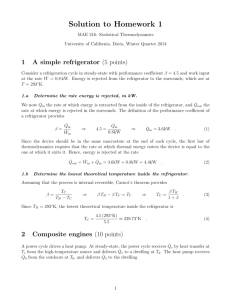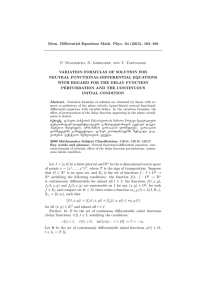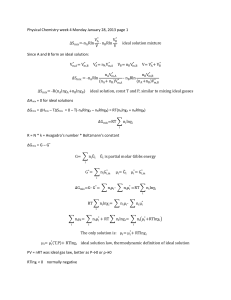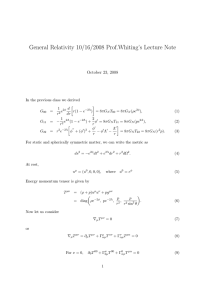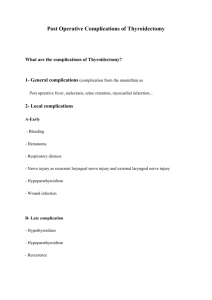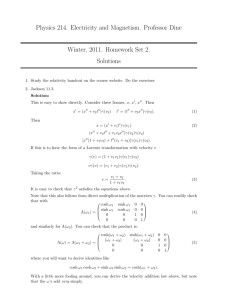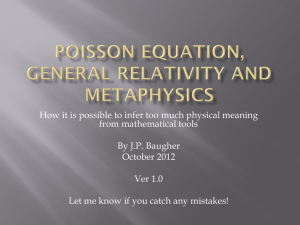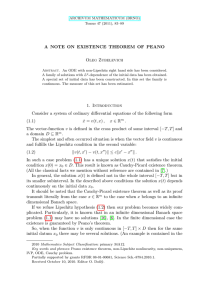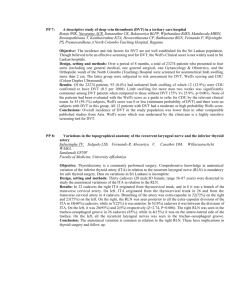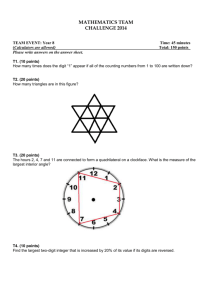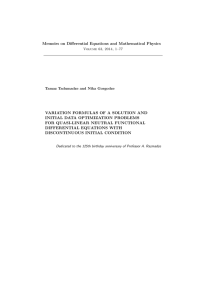Mem. Differential Equations Math. Phys. 58 (2013), 139–146
advertisement
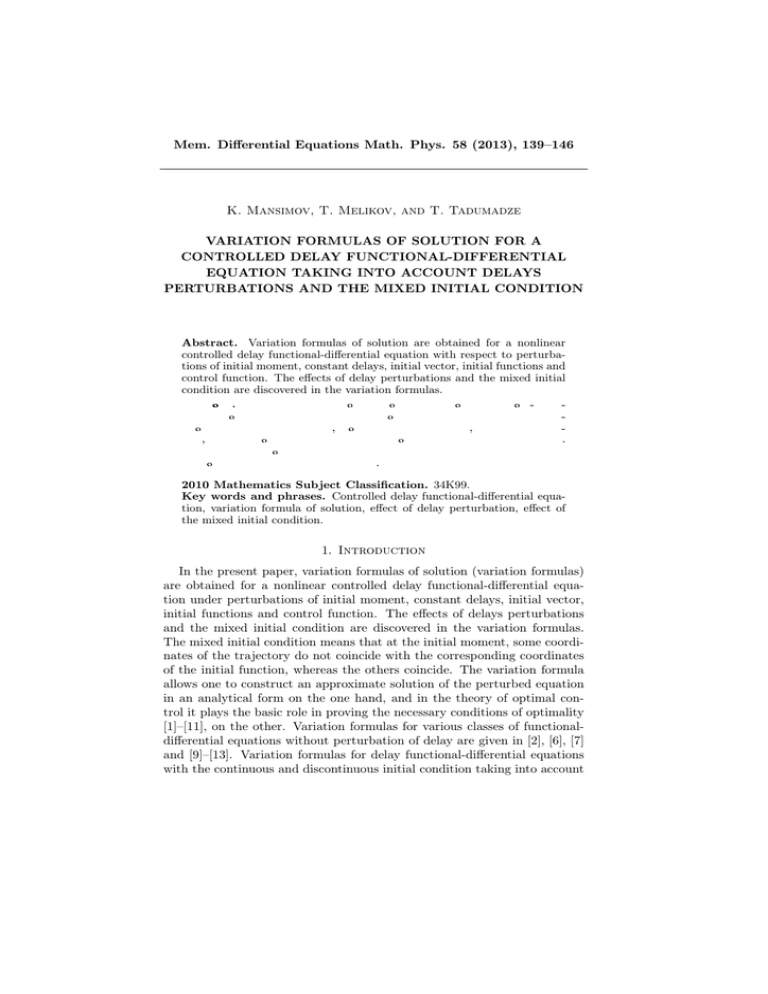
Mem. Differential Equations Math. Phys. 58 (2013), 139–146
K. Mansimov, T. Melikov, and T. Tadumadze
VARIATION FORMULAS OF SOLUTION FOR A
CONTROLLED DELAY FUNCTIONAL-DIFFERENTIAL
EQUATION TAKING INTO ACCOUNT DELAYS
PERTURBATIONS AND THE MIXED INITIAL CONDITION
Abstract. Variation formulas of solution are obtained for a nonlinear
controlled delay functional-differential equation with respect to perturbations of initial moment, constant delays, initial vector, initial functions and
control function. The effects of delay perturbations and the mixed initial
condition are discovered in the variation formulas.
æØ . Ø
Æ ª Œ æŁ
æØ Œ
Œ æŒ ø ºŒ Łæ -Æ Œø Łæ
Œ ºŁ
ª Ø
æŁ
غŒ Œ ª
ø
ºØæŁ
ßı
ØºØ Œ
, ØæÆØ ª Æ ª Œ
,
ßı
ª º, ßı
æŒ ø
Æ Ø
ª
æŒ ø
º
Ø Ø
.
ª
ø
º ØæŁ
غªŁ Œ Ł Æ ª Œ
º
Æ
æŁ
ßı
º
.
2010 Mathematics Subject Classification. 34K99.
Key words and phrases. Controlled delay functional-differential equation, variation formula of solution, effect of delay perturbation, effect of
the mixed initial condition.
1. Introduction
In the present paper, variation formulas of solution (variation formulas)
are obtained for a nonlinear controlled delay functional-differential equation under perturbations of initial moment, constant delays, initial vector,
initial functions and control function. The effects of delays perturbations
and the mixed initial condition are discovered in the variation formulas.
The mixed initial condition means that at the initial moment, some coordinates of the trajectory do not coincide with the corresponding coordinates
of the initial function, whereas the others coincide. The variation formula
allows one to construct an approximate solution of the perturbed equation
in an analytical form on the one hand, and in the theory of optimal control it plays the basic role in proving the necessary conditions of optimality
[1]–[11], on the other. Variation formulas for various classes of functionaldifferential equations without perturbation of delay are given in [2], [6], [7]
and [9]–[13]. Variation formulas for delay functional-differential equations
with the continuous and discontinuous initial condition taking into account
140
constant delay perturbation are proved in [14] and [15], respectively. Variation formulas for controlled delay functional-differential equations with the
continuous initial condition taking into account constant delay perturbation
are proved in [16].
2. Formulation of the Main Results
Rxn
Let
be the n-dimensional vector space of points x = (x1 , . . . , xn )T ,
where T denotes transposition; suppose P ⊂ Rpk , Z ⊂ Rzm and W ⊂ Rur
are open sets and O = (P, Z)T = {x = (p, z)T ∈ Rxn : p ∈ P, z ∈ Z}, with
k+m = n. Let the n-dimensional function f (t, x, p, z, u) satisfy the following
conditions: for almost all t ∈ I = [a, b], the function f (t, ·) : O×P ×Z×W →
Rxn is continuously differentiable; for any (x, p, z, u) ∈ O × P × Z × W ,
the functions f (t, x, p, z, u), fx (·), fp (·), fz (·)fu (·) are measurable on I; for
arbitrary compacts K ⊂ O, U ⊂ W there exists a function mK,U (·) ∈
L(I, [0, ∞)), such that for any x ∈ K, (p, z)T ∈ K, u ∈ U and for almost all
t ∈ I the inequality
|f (t, x, p, z, u)| + |fx (·)| + |fp (·)| + |fz (·)| + |fu (·)| ≤ mK,U (t)
is fulfilled.
Let 0 < τ1 < τ2 , 0 < σ1 < σ2 be the given numbers and Eϕ = Eϕ (I1 , Rpk )
τ , b], τb =
be the space of continuous functions ϕ : I1 → Rpk , where I1 = [b
a − max{τ2 , σ2 }. Further,
©
ª
©
ª
Φ = ϕ ∈ Eϕ : ϕ(t) ∈ P and G = g ∈ Eg = Eg (I1 , Rzm ) : g(t) ∈ Z
are the sets of initial functions. Let Eu be the space of bounded measurable
functions u : I → Rur and Ω = {u ∈ Eu : u(t) ∈ W , t ∈ I, cl u(I) ⊂ W }
be a set of control functions, where u(I) = {u(t) : t ∈ I} and cl u(I) is the
closure of the set u(I).
To any element
µ = (t0 , τ, σ, p0 , ϕ, g, u) ∈ Λ = (a, b) × (τ1 , τ2 ) × (σ1 , σ2 ) × P × Φ × G × Ω,
we assign the controlled delay functional-differential equation
¡
¢
ẋ(t) = (ṗ(t), ż(t))T = f t, x(t), p(t − τ ), z(t − σ), u(t)
(2.1)
with a mixed initial condition
x(t) = (ϕ(t), g(t))T , t ∈ [b
τ , t0 ), x(t0 ) = (p0 , g(t0 ))T .
(2.2)
The condition (2.2) is said to be a mixed initial condition; it consists of two
parts: the first part is p(t) = ϕ(t), t ∈ [b
τ , t0 ), p(t0 ) = p0 , the discontinuous
part, since generally p(t0 ) 6= ϕ(t0 ); the second part is z(t) = g(t), t ∈ [b
τ , t0 ],
the continuous part, since always z(t0 ) = g(t0 ).
Definition 2.1. Let µ = (t0 , τ, σ, p0 , ϕ, g, u) ∈ Λ. A function x(t) =
x(t; µ) ∈ O, t ∈ [b
τ , t1 ], t1 ∈ (t0 , b), is called a solution of equation (2.1)
with the initial condition (2.2) or a solution corresponding to the element
µ and defined on the interval [b
τ , t1 ] if it satisfies the condition (2.2) and is
141
absolutely continuous on the interval [t0 , t1 ] and satisfies the equation (2.1)
almost everywhere on [t0 , t1 ].
Let µ0 = (t00 , τ0 , σ0 , p00 , ϕ0 , g0 , u0 ) ∈ Λ be a fixed element. In the space
Eµ = Rt10 × Rτ1 × Rσ1 × Rpk × Eϕ × Eg × Eu we introduce the set of variations
½
V =
δµ = (δt0 , δτ, δσ, δp0 , δϕ, δg, δu) ∈ Eµ − µ0 : |δt0 | ≤ α,
|δτ | ≤ α, |δσ| ≤ α, |δp0 | ≤ α, δϕ =
ν
X
λi δϕi ,
i=1
δg =
ν
X
i=1
λi δgi , δu =
ν
X
¾
λi δui , |λi | ≤ α, i = 1, ν ,
i=1
where δϕi ∈ Eϕ − ϕ0 , δgi ∈ Eg − g0 , δui ∈ Eu − u0 , i = 1, ν, are the fixed
functions; α > 0 is a fixed number.
Let x0 (t) = (p0 (t), z0 (t))T be the solution corresponding to the element
µ0 and defined on the interval [b
τ , t10 ], with t10 < b. There exist numbers
δ1 > 0 and ε1 > 0 such that for arbitrary (ε, δµ) ∈ [0, ε1 ] × V we have
µ0 + εδµ ∈ Λ. In addition, to this element there corresponds the solution
x(t; µ0 + εδµ) defined on the interval [b
τ , t10 + δ1 ] ⊂ I1 (see Theorem 5.3 in
[17, p. 111]).
Due to the uniqueness, the solution x(t; µ0 ) is a continuation of the solution x0 (t) on the interval [b
τ , t10 + δ1 ]. Therefore, the solution x0 (t) is
assumed to be defined on the interval [b
τ , t10 + δ1 ].
Let us define the increment of the solution x0 (t) = x(t; µ0 ):
∆x(t; εδµ) = x(t; µ0 + εδµ) − x0 (t), (t, ε, δµ) ∈ [b
τ , t10 + δ1 ] × [0, ε1 ] × V.
Theorem 2.1. Let the following conditions hold:
2.1. t00 + τ0 < t10 ;
2.2. the functions ϕ0 (t), g0 (t), t ∈ I1 , are absolutely continuous and
ϕ̇0 (t), ġ0 (t) are bounded; there exist compact sets K0 ⊂ O and U0 ⊂
W containing neighborhoods of sets (ϕ0 (I1 ), g0 (I1 ))T ∪ x0 ([t00 , t10 ])
and cl u0 (I), respectively, such that the function f (t, x, p, z, u),
(t, x) ∈ I × K0 , (p, z)T ∈ K0 , u ∈ U0 , is bounded;
2.3. there exist the limits
lim ġ0 (t) = ġ0− ,
t→t00 −
lim f (w, u0 (t)) = f0− , w ∈ (t00 − τ0 , t00 ]×O×P ×Z,
£
¤
−
lim
f (w1 , u0 (t)) − f (w2 , u0 (t)) = f01
,
w→w0
(w1 ,w2 )→(w01 ,w02 )
w1 , w2 ∈ (t00 , t00 + τ0 ] × O × P × Z,
142
where
w = (t, x, p, z),
¡
¢
w0 = t00 , x00 , ϕ0 (t00 − τ0 ), g0 (t00 − σ0 ) ,
x00 = (p00 , g0 (t00 ))T ,
¡
¢
w01 = t00 + τ0 , x0 (t00 + τ0 ), p00 , z0 (t00 + τ0 − σ0 ) ,
¡
¢
w02 = t00 + τ0 , x0 (t00 + τ0 ), ϕ0 (t00 ), z0 (t00 + τ0 − σ0 ) .
Then there exist numbers ε2 ∈ (0, ε1 ] and δ2 ∈ (0, δ1 ] such that
∆x(t; εδµ) = εδx(t; δµ) + o(t; εδµ)
(2.3)
for arbitrary
©
ª
(t, ε, δµ) ∈ [t10 − δ2 , t10 + δ2 ]×[0, ε2 ]× δµ ∈ V : δt0 ≤ 0, δτ ≤ 0, δσ ≤ 0 ,
where
n
o
£
¤
−
δx(t; δµ) = Y (t00 ; t) (Θk×1 , ġ0− )T − f0− − Y (t00 + τ0 ; t)f01
δt0 −
−
− Y (t00 + τ0 ; t)f01
δτ + β(t; εδµ),
(2.4)
T
β(t; εδµ) = Y (t00 ; t)(δp0 , δg(t00 )) −
½ Zt
¾
−
Y (ξ; t)fp [ξ]ṗ0 (ξ − τ0 ) dξ δτ −
t00
½ Zt
−
¾
Y (ξ; t)fz [ξ]ż0 (ξ − σ0 ) dξ δσ+
t00
Zt00
+
Y (ξ + τ0 ; t)fp [ξ + τ0 ]δϕ(ξ) dξ+
t00 −τ0
Zt00
+
Y (ξ + σ0 ; t)fz [ξ + σ0 ]δg(ξ) dξ+
t00 −σ0
Zt
+
Y (ξ; t)fu [ξ]δu(ξ) dξ;
(2.5)
t00
lim
ε→0
o(t; εδµ)
=0
ε
uniformly for
©
ª
(t, δµ) ∈ [t10 − δ2 , t10 + δ2 ] × δµ ∈ V : δt0 ≤ 0, δτ ≤ 0, δσ ≤ 0 ;
143
Θk×1 is the k × 1 zero matrix, Y (s; t) is the n × n matrix function satisfying
on the interval [t00 , t] the equation
³
´
Yξ (ξ; t) = −Y (ξ; t)fx [ξ] − Y (ξ + τ0 ; t)fp [ξ + τ0 ], Y (ξ + σ0 ; t)fz [ξ + σ0 ] ,
and the condition
(
Y (ξ; t) =
Hn×n
Θn×n
for ξ = t,
for ξ > t.
Here, Hn×n is the n × n identity matrix,
³
´
fx [ξ] = fx ξ, x0 (ξ), p0 (ξ −τ0 ), z0 (ξ −σ0 ), u0 (ξ) , ṗ0 (ξ −τ0 ) = ṗ0 (s)|s=ξ−τ0 ,
under ṗ0 (s) is assumed derivative of the function p0 (s) on the set [b
τ , t00 ) ∪
(t00 , t10 + δ2 ].
Some comments. The function δx(t; δµ) is called the variation of the
solution x0 (t) on the interval [t10 − δ2 , t10 + δ2 ] and the expression (2.4) is
called the variation formula.
c 1) Theorem 2.1 corresponds to the case where the variations at the
points t00 , τ0 , σ0 are performed simultaneously on the left.
c 2) The addend
½
¾
Zt
− Y (t00 +
−
τ0 ; t)f01
+
Y (ξ; t)fp [ξ]ṗ0 (ξ − τ0 ) dξ δτ −
t00
½ Zt
−
¾
Y (ξ; t)fz [ξ]ż0 (ξ − σ0 ) dξ δσ
t00
is the effect of perturbations of the delays τ0 and σ0 (see (2.4) and
(2.5)).
c 3) The expression
Y (t00 ; t)(δp0 , δg(t00 ))T +
¾
½
¤
£
−
− T
−
+ Y (t00 ; t) (Θk×1 , ġ0 ) − f0 − Y (t00 + τ0 ; t)f01 δt0
is the effect of the mixed initial condition (2.2) under perturbations
of initial moment t00 , initial vector p00 and function g0 (t).
144
c 4) The expression
Zt00
Y (ξ + τ0 ; t)fp [ξ + τ0 ]δϕ(ξ) dξ+
t00 −τ0
Zt00
+
Zt
Y (ξ + σ0 ; t)fz [ξ + σ0 ]δg(ξ) dξ +
t00 −σ0
Y (ξ; t)fu [ξ]δu(ξ) dξ
t00
in the formula (2.5) is the effect of perturbations of the initial functions ϕ0 (t), g0 (t) and the control function u0 (t).
c 5) The variation formula allows one to obtain an approximate solution
of the perturbed functional-differential equation
³
´
ẋ(t) = f t, x(t), p(t − τ0 − εδτ ), z(t − σ0 − εδσ), u0 (t) + εδu(t)
with the perturbed initial condition
¡
¢T
x(t) = ϕ0 (t) + εδϕ(t), g0 (t) + εδg(t) , t ∈ [b
τ , t00 + εδt0 ),
¡
¢T
x(t00 + εδt0 ) = p00 + εδp0 , g0 (t00 ) + εδg(t00 ) .
In fact, for a sufficiently small ε ∈ (0, ε2 ] from (2.3) it follows that
x(t; µ0 + εδµ) ≈ x0 (t) + εδx(t; δµ).
Theorem 2.2. Let the conditions 2.1 and 2.2 of Theorem 2.1 hold.
Moreover, there exist the limits
lim ġ0 (t) = ġ0+ ,
t→t00 +
lim f (w, u0 (t)) = f0+ , w ∈ [t00 , t10 ) × O × P × Z,
£
¤
+
lim
f (w1 , u0 (t)) − f0 (w2 , u0 (t)) = f01
,
w→w0
(w1 ,w2 )→(w01 ,w02 )
w1 , w2 ∈ [t00 + τ0 , t10 ) × O × P × Z.
Then there exist numbers ε2 ∈ (0, ε1 ] and δ2 ∈ (0, δ1 ] such that for arbitrary
(t, ε, δµ) ∈ [t10 − δ2 , t10 + δ2 ] × [0, ε2 ] × {δµ ∈ V : δt0 ≥ 0, δτ ≥ 0, δσ ≥ 0}
the formula (2.3) holds, where
o
n
¤
£
+
δt0 −
δx(t; δµ) = Y (t00 ; t) (Θk×1 , ġ0+ )T − f0+ − Y (t00 + τ0 ; t)f01
+
− Y (t00 + τ0 ; t)f01
δτ + β(t; εδµ).
Theorem 2.2 corresponds to the case where the variations at the points
t00 , τ0 , σ0 are performed simultaneously on the right.
145
Theorem 2.3. Let the conditions of Theorems 2.1 and 2.2 hold. Moreover,
−
+
(Θk×1 , ġ0− )T − f0− = (Θk×1 , ġ0+ )T − f0+ =: fb0 , f01
= f01
=: fb01 .
Then there exist numbers ε2 ∈ (0, ε1 ] and δ2 ∈ (0, δ1 ] such that for arbitrary
(t, ε, δµ) ∈ [t10 − δ2 , t10 + δ2 ] × [0, ε2 ] × V the formula (2.3) holds, where
n
o
δx(t; δµ) = Y (t00 ; t)fb0 − Y (t00 + τ0 ; t)fb01 δt0 −
− Y (t00 + τ0 ; t)fb01 δτ + β(t; εδµ).
Theorem 2.3 corresponds to the case where at the points t00 , τ0 , σ0 the
two-sided variations are simultaneously performed. Theorems 2.1–2.3 are
proved by the method given in [10]. If t00 + τ0 > t10 , then Theorems 2.1–
2.3 are also valid. In this case the number δ2 is so small that t00 + τ0 >
t10 + δ2 , therefore in the variation formulas we have Y (t00 + τ0 ; t) = Θn×n ,
t ∈ [t10 − δ2 , t10 + δ2 ]. If t00 + τ0 = t10 , then Theorem 2.1 is valid on the
interval [t10 , t10 + δ2 ] and Theorem 2.2 is valid on the interval [t10 − δ2 , t10 ].
References
1. R. V. Gamkrelidze, Fundamentals of optimal control. (Russian) Izdat. Tbilis. Univ.,
Tbilisi, 1975.
2. N. M. Ogustoreli, Time-delay control systems. Academic Press, New York–London,
1966.
3. R. Gabasov and F. Kirillova, The qualitative theory of optimal processes.
(Russian) Monographs in Theoretical Foundations of Technical Cybernetics. Izdat.
“Nauka”, Moscow, 1971.
4. L. W. Neustadt, Optimization. A theory of necessary conditions. With a chapter
by H. T. Banks. Princeton University Press, Princeton, N. J., 1976.
5. B. Sh. Mordukhovich, Approximation methods in optimization and control problems. (Russian) Nauka, Moscow, 1987.
6. G. L. Kharatishvili, Z. A. Machaidze, N. I. Markozashvili, and T. A. Tadumadze, Abstract variational theory and its application to optimal problems with
delays. (Russian) Metsniereba, Tbilisi, 1973.
7. K. B. Mansimov, Singular controls in systems with delays. (Russian) ELM, Baku,
1999.
8. M. D. Mardanov, Certain problems of the mathematical theory of optimal processes
with delay. (Russian) Azerb. State Univ., Baku, 1987.
9. T. K. Melikov, Singular controls in hereditary systems. (Russian) ELM, Baku, 2002.
10. G. L. Kharatishvili and T. A. Tadumadze, Formulas for the variation of a solution
and optimal control problems for differential equations with retarded arguments.
(Russian) Sovrem. Mat. Prilozh. No. 25, Optimal. Upr. (2005), 3–166; English transl.:
J. Math. Sci. (N. Y.) 140 (2007), No. 1, 1–175.
11. T. Tadumadze, Formulas of variation for solutions for some classes of functional
differential equations and their applications. Nonlinear Anal. 71 (2009), No. 12,
e706–e710.
12. T. Tadumadze and L. Alkhazishvili, Formulas of variation of solution for nonlinear controlled delay differential equations with continuous initial condition. Mem.
Differential Equations Math. Phys. 31 (2004), 83–97.
146
13. L. Alkhazishvili and M. Iordanishvili, Local variation formulas for solution of
delay controlled differential equation with mixed initial condition. Mem. Differential
Equations Math. Phys. 51 (2010), 17–41.
14. T. Tadumadze, Variation formulas of solution for nonlinear delay differential equations taking into account delay perturbation and discontinuous initial condition.
Georgian Int. J. Sci. Technol. 3 (2011), No. 1, 1–19.
15. T. Tadumadze, Variation formulas of solution for a delay differential equation taking
into account delay perturbation and the continuous initial condition. Georgian Math.
J. 18 (2011), No. 2, 345–364.
16. T. Tadumadze and A. Nachaoui, Variation formulas of solution for a controlled
functional-differential equation considering delay perturbation. TWMS J. Appl. Eng.
Math. 1 (2011), No. 1, 58–68.
17. T. A. Tadumadze, Some problems in the qualitative theory of optimal control. (Russian) Tbilis. Gos. Univ., Tbilisi, 1983.
(Received 09.01.2012)
Author’s address:
K. Mansimov
1. Baku State University, 23 Z. Khalilov St., Baku-Az 1148, Azerbaijan.
2. Institute of Cybernetics of NAS Azerbaijan, 9 F. Agaev St., Baku-Az
1141, Azerbaijan.
E-mail: mansimov@front.ru; mansimov kamil@mail.ru
T. Melikov
Azerbaijan Technological University, 103, Sh. I. Khatai Ave., Ganja-Az
2011, Azerbaijan
E-mail: t.melikov@rambler.ru
T. Tadumadze
I. Javakhishvili Tbilisi State University, Department of Mathematics &
I.Vekua Institute of Applied Mathematics, 2 University St., Tbilisi 0186,
Georgia.
E-mail: tamaztad@yahoo.com; tamaz.tadumadze@tsu.ge
